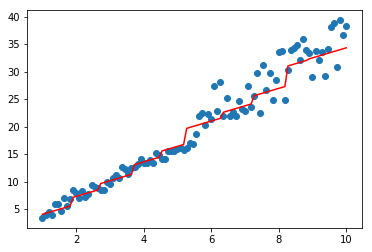一.简介
为了让学习器越发的不同,randomforest的思路是在bagging的基础上再做一次特征的随机抽样,大致流程如下:
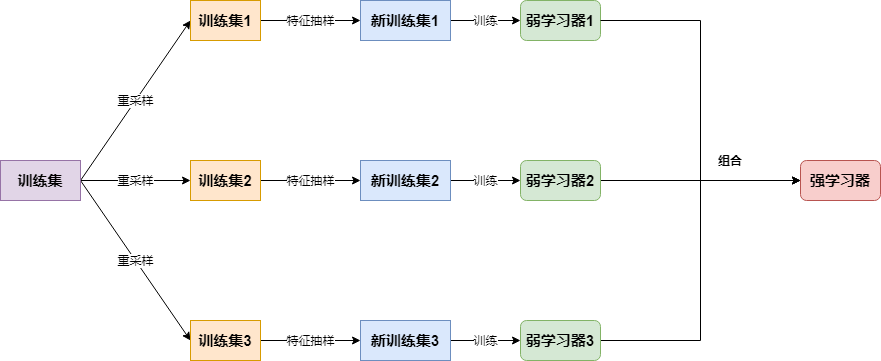
二.RandomForest:分类实现
import os
os.chdir('../')
from ml_models import utils
from ml_models.tree import CARTClassifier
import copy
import numpy as np
"""
randomforest分类实现,封装到ml_models.ensemble
"""
class RandomForestClassifier(object):
def __init__(self, base_estimator=None, n_estimators=10, feature_sample=0.66):
"""
:param base_estimator: 基学习器,允许异质;异质的情况下使用列表传入比如[estimator1,estimator2,...,estimator10],这时n_estimators会失效;
同质的情况,单个estimator会被copy成n_estimators份
:param n_estimators: 基学习器迭代数量
:param feature_sample:特征抽样率
"""
self.base_estimator = base_estimator
self.n_estimators = n_estimators
if self.base_estimator is None:
# 默认使用决策树
self.base_estimator = CARTClassifier()
# 同质分类器
if type(base_estimator) != list:
estimator = self.base_estimator
self.base_estimator = [copy.deepcopy(estimator) for _ in range(0, self.n_estimators)]
# 异质分类器
else:
self.n_estimators = len(self.base_estimator)
self.feature_sample = feature_sample
# 记录每个基学习器选择的特征
self.feature_indices = []
def fit(self, x, y):
# TODO:并行优化
n_sample, n_feature = x.shape
for estimator in self.base_estimator:
# 重采样训练集
indices = np.random.choice(n_sample, n_sample, replace=True)
x_bootstrap = x[indices]
y_bootstrap = y[indices]
# 对特征抽样
feature_indices = np.random.choice(n_feature, int(n_feature * self.feature_sample), replace=False)
self.feature_indices.append(feature_indices)
x_bootstrap = x_bootstrap[:, feature_indices]
estimator.fit(x_bootstrap, y_bootstrap)
def predict_proba(self, x):
# TODO:并行优化
probas = []
for index, estimator in enumerate(self.base_estimator):
probas.append(estimator.predict_proba(x[:, self.feature_indices[index]]))
return np.mean(probas, axis=0)
def predict(self, x):
return np.argmax(self.predict_proba(x), axis=1)
#造伪数据
from sklearn.datasets import make_classification
data, target = make_classification(n_samples=100, n_features=2, n_classes=2, n_informative=1, n_redundant=0,
n_repeated=0, n_clusters_per_class=1, class_sep=.5,random_state=21)
#同质
classifier = RandomForestClassifier(feature_sample=0.6)
classifier.fit(data, target)
utils.plot_decision_function(data, target, classifier)
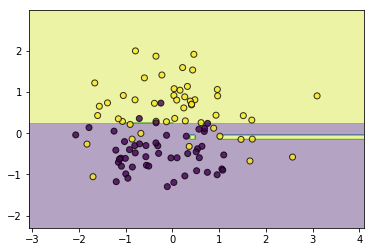
#异质
from ml_models.linear_model import LogisticRegression
from ml_models.svm import SVC
classifier = RandomForestClassifier(base_estimator=[LogisticRegression(),SVC(kernel='rbf',C=5.0),CARTClassifier(max_depth=2)],feature_sample=0.6)
classifier.fit(data, target)
utils.plot_decision_function(data, target, classifier)
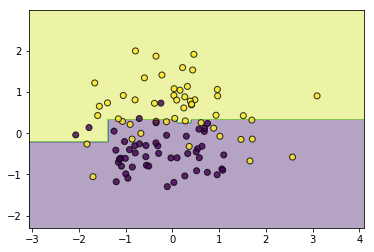
三.代码实现:回归
from ml_models.tree import CARTRegressor
"""
random forest回归实现,封装到ml_models.ensemble
"""
class RandomForestRegressor(object):
def __init__(self, base_estimator=None, n_estimators=10, feature_sample=0.66):
"""
:param base_estimator: 基学习器,允许异质;异质的情况下使用列表传入比如[estimator1,estimator2,...,estimator10],这时n_estimators会失效;
同质的情况,单个estimator会被copy成n_estimators份
:param n_estimators: 基学习器迭代数量
:param feature_sample:特征抽样率
"""
self.base_estimator = base_estimator
self.n_estimators = n_estimators
if self.base_estimator is None:
# 默认使用决策树
self.base_estimator = CARTRegressor()
# 同质
if type(base_estimator) != list:
estimator = self.base_estimator
self.base_estimator = [copy.deepcopy(estimator) for _ in range(0, self.n_estimators)]
# 异质
else:
self.n_estimators = len(self.base_estimator)
self.feature_sample = feature_sample
# 记录每个基学习器选择的特征
self.feature_indices = []
def fit(self, x, y):
# TODO:并行优化
n_sample, n_feature = x.shape
for estimator in self.base_estimator:
# 重采样训练集
indices = np.random.choice(n_sample, n_sample, replace=True)
x_bootstrap = x[indices]
y_bootstrap = y[indices]
# 对特征抽样
feature_indices = np.random.choice(n_feature, int(n_feature * self.feature_sample), replace=False)
self.feature_indices.append(feature_indices)
x_bootstrap = x_bootstrap[:, feature_indices]
estimator.fit(x_bootstrap, y_bootstrap)
def predict(self, x):
# TODO:并行优化
preds = []
for index, estimator in enumerate(self.base_estimator):
preds.append(estimator.predict(x[:, self.feature_indices[index]]))
return np.mean(preds, axis=0)
#构造数据
data = np.linspace(1, 10, num=100)
target1 = 3*data[:50] + np.random.random(size=50)*3#添加噪声
target2 = 3*data[50:] + np.random.random(size=50)*10#添加噪声
target=np.concatenate([target1,target2])
data = data.reshape((-1, 1))
#同质
import matplotlib.pyplot as plt
model=RandomForestRegressor(base_estimator=CARTRegressor(),n_estimators=2,feature_sample=1)#feature就一列,没办法...
model.fit(data,target)
plt.scatter(data, target)
plt.plot(data, model.predict(data), color='r')
[<matplotlib.lines.Line2D at 0x18f3f5866d8>]
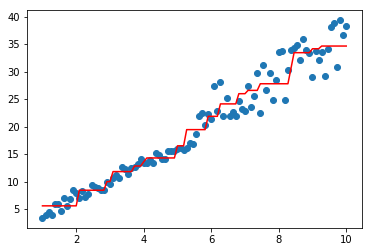
#异质
from ml_models.linear_model import LinearRegression
model=RandomForestRegressor(base_estimator=[LinearRegression(),CARTRegressor()],feature_sample=1)
model.fit(data,target)
plt.scatter(data, target)
plt.plot(data, model.predict(data), color='r')
[<matplotlib.lines.Line2D at 0x18f2d6dd160>]
